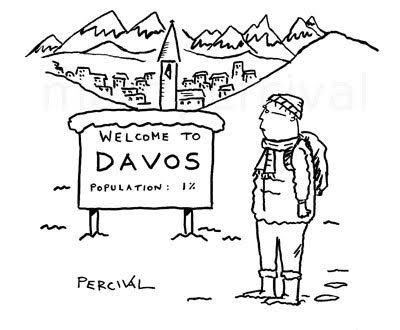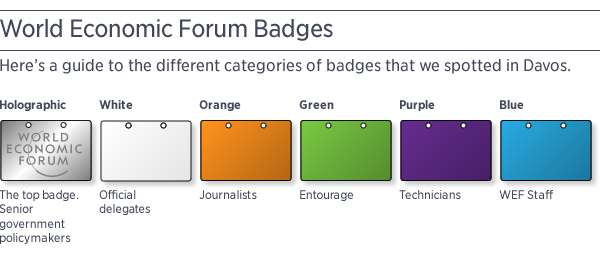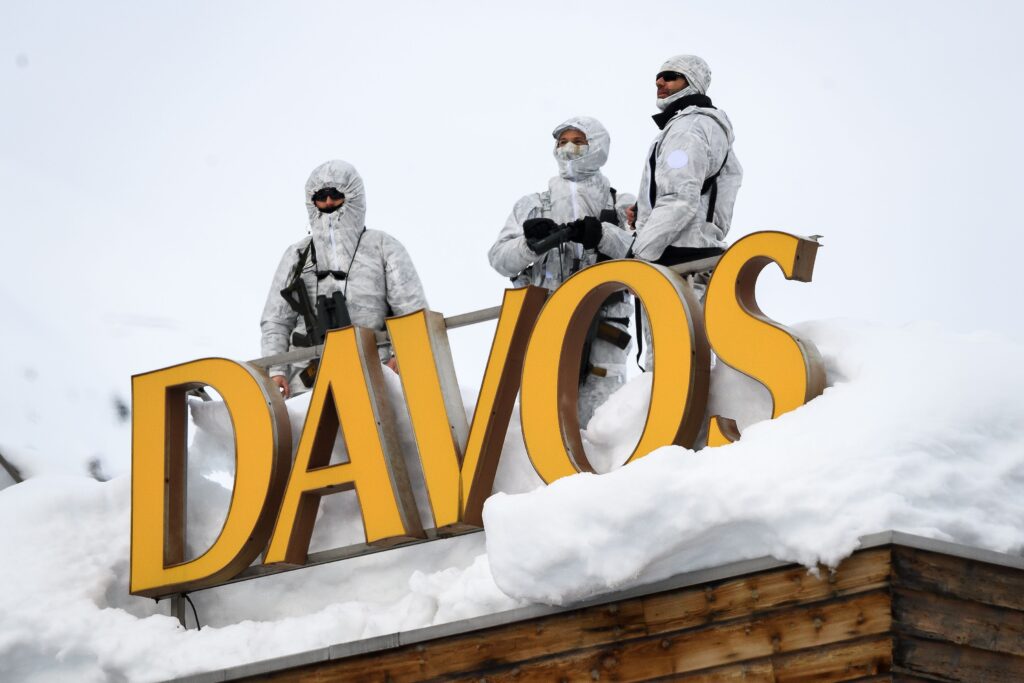The world’s decision-makers are gathering in Davos, Switzerland this week for the World Economic Forum meeting. Herein, a little background on the event.

16 January 2023 – And so we are back to The Magic Mountain as the world’s decision-makers are gathering in Davos, Switzerland this week for the World Economic Forum (WEF) meeting which runs from today through this Saturday. The pandemic and subsequent lockdowns put paid to physical January gatherings in 2021 and 2022, but normal service is now resuming as more than 3,000 politicians, executives, investors, bankers and academics convene in the Swiss ski resort, which does not include the hundreds of behind-the-scenes media, support staff, technicians, etc.
And no Russians will be present again, especially the oligarchs. They once helped bankroll the parties and advertising hoardings, yet have now been frozen out following Putin’s invasion of Ukraine and the resulting imposition of international sanctions.
It is the 53rd such conference and the main theme is a doozy: “Cooperation in a Fragmented World”. There are scores of panels and presentations on our “polycrisis risk attacks”, including what are gong to be some bangers on artificial intelligence and cyberwar – the main reason we are there. Saadia Zahidi, managing director at WEF, probably captured it best. Over the weekend in a Bloomberg Television interview he said:
“This is a crunch-time that leaders are facing, that they’re potentially unprepared for. They will gather amid multiple worries, ranging from Russia’s war in Ukraine to fears a global recession is looming amid a surging cost of living. Plus the concerns over climate change show little sign of dissipating. We have this risk of polycrisis emerging, because so many things are happening at once”.
And besides all of the official events, programs and food feats at the main venue, there are hundreds of corporate, culture, food, and political events along the promenade that cuts through the center of Davos.
And, no, I am not at Davos this year but two of my staffers are attending. As someone entering his dotage, best to cover it from afar and let the kids do the heavy lifting.
But I have attended 3 times. The first time under a “purple badge” (the badge reserved for technicians who work behind the scenes, courtesy of a long-time media client) and the next two times as a member of the press after a looooooooong, multi-year application process to get a media badge. I’ll explain the badge hierarchy in a moment.
WEF can be a bit overwhelming. Primarily attended by middle-aged men. Although the WEF speaker roster is now 42% female, while overall female participation is (only) 27 percent — both figures are new highs for WEF.
And yes, “Davos Man” is lost in a blizzard of complexity – plutocrats and politicians who still rule the world have been given a shock this year over artificial intelligence, climate change and the war in Ukraine. Samuel Huntington must be laughing in his grave. More than a decade ago the prescient political scientist popularized the term “Davos Man” in an 2004 essay. And he was not being complimentary. He coined the phrase to symbolize the “emerging global superclass.” His essay on this trope was titled “Dead Souls.” The rootless, denationalized elites, he argued, were out of touch with ordinary people’s yearning for tradition and community. In Huntington’s vision, the people gathered were the problem, a condescending cabal that sought to impose its homogenizing will on the world.
But for me, WEF remains a tsunami of content and fascinating conversations that all seem interesting … even those you simply overhear but which you are just not part of. I’ll conclude with my thoughts on the event but herein a little background on the structure of the event.
BADGES

Life in the Congress Centre is ruled by the color of your badge (except for actual ministers and leaders who cruise the halls badgeless). In Davos, you are white, orange, purple or green.
White badges open all doors and are generally given out to corporate executives, government officials and media leaders. Holders of white badges can attend the hundreds of sessions, lunches, dinners and night-caps, as long as they sign up through a dedicated app beforehand. White badge life is strictly off the record.
Most journalists operate with the orange badge, which offers limited access to the Congress Centre and surrounding hotels. Still, reporters get unparalleled proximity to the world’s most powerful with the orange badge but are blocked entry to VIP rooms and special meeting areas.
Purple badges are for technical workers, while green badges go to the entourage of top officials.
Obviously the most coveted badge in all of Davos is one with a shiny holographic sticker on it — despite the fact that most attendees, and even some Forum employees, don’t actually know what the sticker actually means. It’s seen on the badge of every head of state, so some people thinks it means you are a head of state. It doesn’t. In fact, the shiny hologram grants you entry to the hyper-exclusive Davos-within-Davos known as IGWEL, or the Informal Gathering of World Economic Leaders.
To get in, you need to be a senior government policymaker — think finance minister, or trade minister, or one of their sherpas — or one of a very select group of WEF employees. And in fact the exclusivity does seem to help: if anything useful has ever been achieved at Davos, it has probably been achieved at IGWEL, which remains one of very few occasions where international politicians can meet informally, off the record, to talk about their biggest aspirations. Mexican president Carlos Salinas once said that the idea of NAFTA first emerged at an IGWEL. But don’t expect anything that ambitious to emerge this year: the politicians will probably spend more time commiserating than conspiring.
THE COST TO ATTEND DAVOS

Here is the approximate cost to attendees for mingling with the swells at Davos. You pay in Swiss francs but I have converted everything into U.S. dollars :
• An annual membership to the World Economic Forum (required if you want to buy a ticket to Davos) starts at $62,000 and can run to $660,000. A ticket to Davos itself costs $28,000 but the WEF waives the fee for all attendees who are not there to represent a business. But you still must have an annual membership to attend. NOTE: only businesses pay to attend the event.
• The crappiest hotel rooms are $500 a night, and a private chalet costs $140,000 for the week. The good hotels raise their prices to five times their normal rate during the conference. We book an Airbnb for three years in advance and that averages out to $100 a night. But we pay for the whole three years in advance.
• If you want to go to the private industry sessions, which everyone here agrees are where the real value is, you have to become an “Industry Associate,” which costs $145,000 a year.
• If you want to bring a colleague, you can’t just buy another ticket for $28,000 — you have upgrade your membership to “Industry Partner,” which costs about $275,000.
• And that’s just the cost of the conference. If you want to throw a party at Davos, which every self-respecting corporate attendee does, it will set you back at least $350 per guest (I had a long chat with two of the catering companies that handle Davos). And you have to get here, which will cost you $1,000 – $100,000 depending on what size plane you fly in on (commercial or private) and whether you want to drive from Zurich or fly in a helicopter ($4,000).
So it’s no surprise that some companies spend “millions” on the Annual Meeting each year, as a senior executive at one big Davos sponsor told me.
SECURITY

The WEF was founded on 24 January 1971 by German engineer and economist Klaus Schwab who remains its head. He choose Davos because it was small, intimate – the presentation venues and hotels were in close proximity. But as the event grew in importance and the level of its attendees grew (more heads of state) and geopolitics reared its ugly head, security became paramount. The town remans small with limited access to it is easy to protect.
As such, security is both conspicuous and discreet in Davos. The town goes into lockdown for the week of the event, and security is very high. Snipers sit on roofs and police with automatic weapons and guard dogs blockade the roads. The Swiss army provides aerial support while security officers trample through snow to guard the buildings’ perimeters. Security checks are constant – badges on personnel, vehicles, all bags, and continual vigilance on access roads into the area. It is obviously extremely tight within the main Forum too, known as the Congress Center. I remember being checked 4 times before I was able to actually enter the Congress Center.
The Forum is held in the Swiss state of Graubünden — the Canton of Grisons — and the regional government is in charge of security rather than the country’s Ministry of Defense, although the local authority can ask for help from police teams outside the state as well as from the Swiss armed forces, which do attend the event. Members of my intelligence community tell me a very sophisticated electronic surveillance system is in place, run by Swiss authorities but in co-operation with Western intelligence services.
The total cost of security has been estimated to be about $15 million.
AND THE VALUE OF DAVOS?

And I am no fool. I look only at climate change, where the WEF has made net zero progress. Those endless debates about climate change that have been a feature of the program for years were prescient — take a look around, climate change is literally happening before your eyes, kids. Or the bullshit that the Davos crowd crows about that technological solutions and capitalism being the way out of any crisis. That’s worked out well.
Or all those conversations (most likely only in passing, and probably on the margins of the official program, if even discussed) about the tremendous monopoly and monopsony power of their companies, the ability to play one jurisdiction against another in order to avoid taxes, or how to ban organized labor in their companies, etc., etc.
But whether you think the World Economic Forum is a worthy enterprise or a bunch of baloney and just fat cats whining, it’s an extraordinary creation. It is a tsunami of content and fascinating conversations that all seem interesting but, as I noted, of which often you are not part of. And it is due to one fundamental underpinning in all of this: the accelerating volume and velocity of information. Cultures, institutions, and individuals are, among many other things, information-processing mechanisms. For that reason alone, WEF is an education in dynamics.